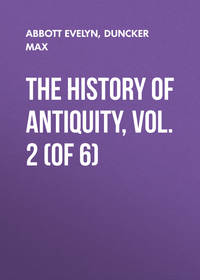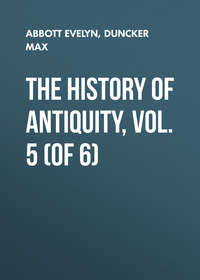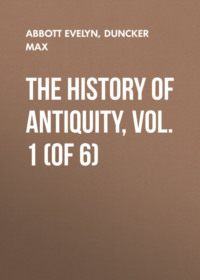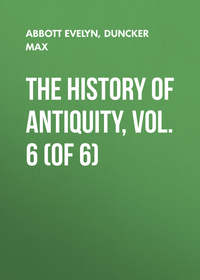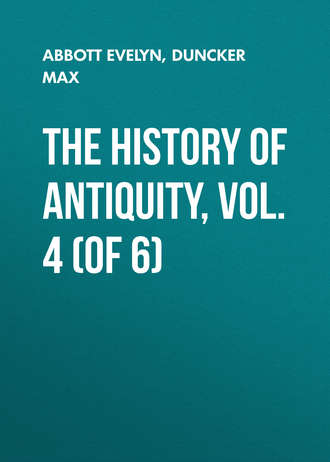 полная версия
полная версияThe History of Antiquity, Vol. 4 (of 6)
We have no further accounts from the West about the Aryas till the year 500 B.C., and later. It is not improbable that the arms of Cyrus reached the Indus. The Astacenes and Assacanes are said to have been subject to the Medes after the Assyrians; then Cyrus, the son of Cambyses, imposed tribute upon them.13 As Cyrus subjugated Bactria, fought in Arachosia, and marched through Gedrosia, we may assume that he compelled the nations of the Aryas on the right bank of the Indus to pay tribute. It was in conflict with the Derbiccians, to whom the Indians sent elephants as auxiliaries, that Cyrus, according to the account of Ctesias, was slain. Darius, as Herodotus tells us, sent messengers to explore the land of the Indus. Setting out from Arachosia, they proceeded from Caspapyrus (Kaçpapura), a city which, according to Hecatæus, belonged to the Gandarii14—i. e. without doubt from Kabura (Cabul) down the Indus to the sea. According to Herodotus' account the Gandarii, together with the Arachoti and Sattagydæ, paid 170 talents of gold yearly; the rest of the Indians paid a larger tribute than any other satrapy – 360 talents of gold.15 The Indians who paid this tribute were, according to Herodotus, the most northerly and the most warlike of this great nation. They dwelt near the city of Caspapyrus, i. e. near Cabul; their mode of life was like that of the Bactrians, and they obtained the gold from a sandy desert, where ants, smaller than dogs, but larger than foxes, dug up the gold-dust.16 Darius tells us himself, in the inscriptions of Persepolis, that the Gandarii and the Indians were subject to him. Like Herodotus, these inscriptions comprise the tribes of the Aryas on the right bank of the Indus as far down as Cabul under the name of Indians, so that the Açvakas were included among them. The Gandarii, as is shown by their vicinity to and connection with the Arachoti, lay to the south of Cabul. In the epos of the Indians the daughter of the king of the Gandharas is married to the king of the Bharatas, who lie between the Yamuna and the Ganges, and the Buddhist writings speak of the Brahmans of the Gandarii as the worst in India.17 In the campaign of Xerxes, Herodotus separates the Gandarii from the rest of the Indians who are subject to the Persian kingdom. The first, he says, were armed like the Bactrians; with the rest marched the Ethiopians of the East, equipped almost like the Indians; but on their heads they had the skins of horses' heads, with the ears and mane erect, and their shields were made from the skins of cranes. These Ethiopians of the East were not distinguished from the others in form and character, but by their language and hair. The Libyan Ethiopians, i. e. the negroes, had the curliest hair of all men; but the hair of the Eastern branch was straight.18 We have already observed that now, as in the days of Xerxes, remains of the dark-coloured pre-Aryan population of India are found on the right bank of the Indus (p. 10).
Of the Indians "who never obeyed Darius,"19 Herodotus tells us that they lived the furthest to the east of all the nations about which anything definite was known. Still further in that direction were sandy deserts. The Indians were the largest of all nations, and the Indus was the only river beside the Nile in which crocodiles are found (they are alligators).20 The remotest parts of the earth have always the best products, and India, the remotest inhabited land to the east, was no exception. The birds and the quadrupeds were far greater in size here than elsewhere, with the exception of the horse; for the Nisæan horses of the Medes were larger than the horses of the Indians. Moreover, India possessed an extraordinary abundance of gold, of which some was dug up from mines, and some brought down by the rivers, and some obtained from the deserts. The wild trees also produced a wool which in beauty and excellence surpassed the wool of sheep; this the Indians used for clothing. There were many nations of the Indians, and they spoke different languages. Some were stationary; some dwelt in the marshes of the rivers, and lived on raw fish, which they caught in canoes made of reeds, and every joint of the reed made a canoe. These Indians wore garments of bark, which they wove like cloths, and then drew on like coats of mail. Eastward of these dwelt the Padæans, a migratory tribe, who ate raw flesh; and when any one, even the nearest relative, among them was sick, they slew him, in order to eat the corpse. This custom was also observed by the women. Even the few who attained to old age they killed, in order to eat them. Other Indian nations lived only on herbs, which they ate cooked, and troubled themselves neither about their sick nor their dead, whom they carried out, like the sick, into desert places. All the nations spoken of were black in colour.21
These, the oldest accounts from the West on the ancient pre-Aryan population of India, and on the black-skins of the Rigveda, we owe to Herodotus. His statements about their physical formation are correct; those on their savage life may be exaggerated; but even to this day a part of these nations live in the marshes and mountains in a condition hardly removed from that of animals.
The contrast between the light-coloured and dark population of India, between the Aryas and the ancient inhabitants, did not escape Ctesias. India, he maintained, was as large as the rest of Asia, and the inhabitants of India almost as numerous as all the other nations put together. The Indians were both white and black. He had himself seen white Indians, five men and two women. The sun in India appeared ten times as large as in other lands, and the heat was suffocating. The Indus was a great river flowing through mountains and plains; in the narrowest places the water occupied a space of 40 stades, or five miles, in the broadest it reached 100 stades.22 The river watered the land. In India it did not rain, and there were no storms there, though there were violent whirlwinds which carried everything before them.23 On the Indus grew reeds small and great; the stoutest reeds could not be spanned by two men, and the height of the largest was equal to the mast of a ship.24 The fruit of the palms also in India was three times as large as in Babylonia, and the sheep and goats there were equal in size to asses elsewhere, and had such enormous tails that they had to be cut off to enable them to walk. Ctesias goes on to describe the large cocks of India, with their beautiful combs, and broad tails of gold, dark-blue, and emerald; the peacocks, the many-coloured birds with red faces, dark-blue necks, and black beards, which had a human tongue, and could speak Indian, and would speak Greek if they were taught; the little apes with tails four cubits long.25 He was the first to describe the elephant to the Greeks.26 He had seen these animals, and had been present in Babylon when the elephants of the Persian king had torn up palm trees with their roots out of the ground. These animals could even throw down the walls of cities. In war the king of India was preceded by 100,000 elephants, and 3000 of the strongest and bravest followed him.27
After the army of Alexander of Macedon had encamped in the Panjab, the Greeks could give more accurate accounts of India. Megasthenes assures us that India reached in breadth, from west to east, an extent of from 15,000 to 16,000 stades (1940 to 2000 miles), while the length, from north to south, was 22,000 stades (2750 miles);28 and in these distances he is not very greatly in error, for, measured in a direct line, the breadth is 13,600 stades (1720 miles), and the length 16,400 stades (2050 miles). To the north India was bounded by lofty mountains, which the Greeks called Caucasus, and the Indians Paropamisos (Paropanishadha29), and Emodos, or Imaos. Emodos, like Imaos, is the Greek form of the old Indian name for the Himalayas, Haimavata (Himavat).30 In India there were many great mountains, but still greater plains; and even the mountains were covered with fruit-trees, and contained in their bowels precious stones of various kinds – crystals, carbuncles, and others. Gold also and silver, metals and salt, could be obtained from the mines,31 and the rivers carried down gold from the mountains.32 The streams of India were the largest and the most numerous in the world. The Indus was larger than the Nile, and all the rivers of Asia; the Ganges, which took an easterly direction on reaching the plains, was a great river even at its source, and reached a width of 100 stades, or 12½ miles. In many places it formed lakes, so that one bank could not be seen from the other, and its depth reached 20 fathoms.33 The first statement is exaggerated, the second is correct for the lower course of the river. The Indus, according to Megasthenes, had 15 navigable affluents, and the Ganges 19, the names of which he could enumerate.34 In all there were 58 navigable rivers in India.
This abundance of streams in India the Greeks explained by the fact that the lands which surrounded the country – Ariana, as the Greeks call eastern Iran, Bactria, and the land of the Scythians – were higher than India, so that the waters from them flowed down, and were collected there.35 The water was also the cause of the great fertility of India, which the Greeks unite in extolling. The rivers not only brought down, as Nearchus observes, soft and good earth into the land from the hills,36 but they traversed it in such a manner that, from the universal irrigation, it was turned into a fruit garden.37 Onesicritus tells us that India is better irrigated by its rivers than Egypt by its canals. The Nile flows straight on through a long and narrow land, and so is continually passing into a different climate and different air, while the Indian rivers flow through much larger and broader plains, and continue long in the same region. Hence they are more nourishing than the Nile, and the fish are larger than the fish in the Nile;38 they also refresh the land better by their moist exhalations.39 Besides, there were the inundations caused by the rivers; and the land was also watered by the heavy rains, which fell constantly each year at a fixed period with the regular winds, so that the rivers rose fully 20 cubits above their beds, – a statement quite accurate, – and in many places the plains were changed into marshes,40 in consequence of which the Indus had sometimes taken a new channel through them.41 Since, then, the warmth of the sun was the same in India as in Arabia and Ethiopia, – for India lay far to the south, and in the most southern parts of the land the constellation of the Bear was seen no longer, and the shadows fell in the other direction, i. e. to the south, —42while in India there was more water and a moister atmosphere than in those other countries, the creatures of the water, air, and land were much larger and stronger in India than anywhere else.43 Further, as the water in the river and that which fell from heaven was tempered by the sun's heat, the growth of the roots and plants was extraordinarily vigorous. The strength of the tiger, which, according to Megasthenes, is twice the size of the lion, the docility of the elephant, the splendour of the birds, were the admiration of the Greeks. With horror they saw the whale for the first time in the Indian waters. Nearchus caused his ship to be rowed forward at double speed to contend with this peaceful monster of the deep.
According to the statement of Megasthenes – which for the land of the Ganges is quite correct – there are two harvests in India. For the winter sowing rice and barley were used, and other kinds of fruit unknown to the Greeks; for the summer sowing, sesame, rice, and bosmoron; while during the rainy season flax and millet were planted, so that in India want and famine were unknown.44 Equally luxuriant in growth were the herbs and reeds. There was a reed there which produced honey without bees (the sugar-cane); and in Southern India cinnamon, nard, and the rest of the spices grew as well as in Arabia and Ethiopia.45 The Greeks did not know that the cinnamon is a native of India only, and that the bark came to them from that country, though it came through Arabia. The marshes of India were filled with roots, wholesome or deadly; the trees there grew to a larger size than elsewhere; some were so tall that an arrow could not be shot over them, and the leaves were as large as shields. There were other trees there of which the trunks could not be spanned by five men, and the branches, as though bent, grew downwards till they touched the earth, and then, springing up anew, formed fresh trunks, to send out other arches, so that from one tree was formed a grove, not unlike a tent supported by many poles. Fifty or even 400 horsemen could take their mid-day rest under such a tree. Nearchus even goes so far as to say that there were trees of this kind under which there was room for 10,000 men.46 There were also trees in India which produced intoxicating fruits. This description of the Indian fig tree and the statements about the shelter its branches afford are not exaggerated. By intoxicating fruits the coco and fan-palms are, no doubt, meant, from which palm-wine is made.47
The northern, i. e. the light-coloured, Indians, or Aryas, are said by the Greeks of this period to have most closely resembled the Egyptians in the colour of their skin and their shape. They were light, delicate, and slim of body, and not so heavy as other nations. They were free from diseases, for their climate was healthy, and their land possessed good air, pure water, and wholesome fruits. The southern Indians, i. e. the non-Aryan population, who were at that time far less broken up in the Deccan by Aryan and other settlers than now, and must therefore have existed in far greater masses, were not quite so black as the Ethiopians (the negroes), and had not, like them, a snub nose and woolly hair. Strabo was of opinion that their colour was not so black owing to the moist air of India, which also caused the hair of the inhabitants to be straight.48 Of the 200 millions, at which the population of India is now estimated, more then 150 millions either spring from the Aryas or have adopted their civilisation. The number of the dark-coloured races, dwelling in the mountains and broad marshes, who have remained free from the dominion of the Aryas, the Mohammedans, and the English, and are, therefore, strangers to their civilisation, is estimated at 12 millions.
CHAPTER II.
THE ARYAS ON THE INDUS
We have already examined the earliest date at which the kings who reigned in antiquity in the lower valley of Nile attempted to bring their actions into everlasting remembrance by pictures and writing. The oldest inscription preserved there dates from the period immediately preceding the erection of the great pyramids. The same impulse swayed the rulers of Babylon and Asshur, of whom we possess monuments reaching beyond the year 2000 B.C. The Hebrews also began at a very early time to record the fortunes of their progenitors and their nation. With the Indians the reverse is the case. Here neither prince nor people show the least interest in preserving the memory of their actions or fortunes. No other nation has been so late in recording their traditions, and has been content to leave them in so fragmentary a condition. For this reason, fancy is in India more lively, the treasures of poetry are more rich and inexhaustible. Thus it becomes the object of our investigation, from the remains of this poetry, and the wrecks of literature, to ascertain and reconstruct, as far as possible, the history of the Indians. From the first the want of fixed tradition precludes the attempt to establish in detail the course of the history of the Aryan states and their rulers. Our attempts are essentially limited to the discovery of the stages in the advance of the power of the Aryas in the regions where they first set foot, to the deciphering of the successive steps through which their religious views and intellectual culture were developed. And when we have thus exhumed the buried history of the Indians, we are assisted in determining its periods by the contact of the Indians with their western neighbours, the Persian kingdom, and the Greeks, and by the accounts of western writers on these events.
The oldest evidence of the life of the Aryas, whose immigration into the region of the Indus and settlement there we have been able to fix about 2000 B.C., is given in a collection of prayers and hymns of praise, the Rigveda, i. e. "the knowledge of thanksgiving." It is a selection or collection of poems and invocations in the possession of the priestly families, of hymns and prayers arising in these families, and sung and preserved by them. In the ten books which make up this collection, the poems of the first book are ascribed to minstrels of various families; in some the minstrel is even named. "This song was made by Dirghatamas, of the race of Angiras;" "this new hymn was composed by Nodhas, a descendant of Gautama." Of the other books, each is ascribed to a single family of priests – to the Gritsamadas, Viçvamitras, Vamadevas, Atris, Bharadvajas, Vasishthas, and Kanvas. The tenth book contains isolated pieces which found no place in the earlier books; several of these pieces bear the stamp of a later origin, as they exhibit a more complicated ritual, the operation of various classes of priests, and reflections of an abstract character.49
We see, then, that from ancient times there were among the Aryas families in possession of effectual invocations of the gods, who knew how to pronounce and sing the prayers at sacrifice, and offer the sacrifice in due form. We may gather further from the Rigveda that these families were distinguished by special symbols. The family of Vasishtha had a coil or knot of hair on the right side,50 the family of Atri had three knots, the family of Angiras five locks, while the Bhrigus shaved their hair.51 Sung for centuries in these families, in these circles of minstrels and priests, these poems were thus revised and preserved, until at length out of the possessions of these schools arose the collection which we have in the Rigveda. We find frequent mention in the poems of the invocations of ancient time, of the prayers of the fathers, and hence what is in itself probable becomes certain – that we have united in the Rigveda poems of various dates, and invocations divided in their origin by centuries.
Though the minstrels of the poems of the Rigveda could look back on a distant past, though they could distinguish the sages of the ancient, the earlier time, and the present, and the men of old from those of the later and most recent times,52 there is yet nothing in these poems to point to an earlier home, to older habitations, or previous fortunes of the nation, unless, indeed, we ought to find an indication of life in a more northern region in the fact that the older poems in the collection count by winters, and the later by autumns.53 In any case there is no remembrance of earlier abodes, and therefore we must conclude that even the oldest of these poems had been sung long after the immigration. If the assumption established above, that the immigration took place soon after 2000 B.C., is approximately probable, the extinction of any memory of earlier abodes and fortunes will hardly allow us to carry back the origin of the oldest songs of the Veda beyond the sixteenth century B.C.
On the other hand, the hymns of the Veda contain conceptions of the creation and early ages of the world, the outlines of which, like the conception of the contrast between the men of the old time and the present, must have been brought by the Aryas into the land of the Indus from the common possession of the Aryan tribes. The oldest man, the father and progenitor of the Aryas, is, in the hymns of the Veda, Manu, the son of Vivasvat, i. e. "the illuminating," the sun. Frequent mention occurs in these poems of the "father Manu," of "our father Manu," "the paternal path which Manu trod," "the children of Manu," "the people of Manu." Manu brought the first offering to the gods of light; with Atharvan and Dadhyanch he kindled the first sacrificial fire; he has set Agni to give light to all the people, and to summon the gods, and prayed to him with Bhrigu and Angiras.54 Five races of men sprung from Agni – the Yadus, the Turvaças, Druhyus, Anus, and Purus.55 Beside Manu stands Yama (geminus), like Manu, the son of Vivasvat. In the hymns of the Rigveda he is the assembler of the people, the king, the pattern of just dealing. He "has discovered the path which leads from the deeps to the heights;" he "has removed the darkness," and "made smooth the path of the godly." He first discovered the resting-place from which no one drives out those who are there. From the depth of the earth he first ascended to the heights of heaven; he has had experience of death, he has entered into heaven, and there gathered round him all the godly and brave. "He went before us, and found for us a dwelling-place on a plain, which no one takes from us, whither the fathers of old time have gone; thither his path guides every child of earth."56
Manu and Yama are not unknown to the mythology of the nations of Iran. With the Iranians Yama is Yima; his father, according to the laws of the Bactrian, the language of East Iran, is not Vivasvat, but Vivanghat. The meaning is of course the same. According to the myths of Iran, Yima is the sovereign who first established the cultus of fire, and first tilled the field with the plough. In his reign of 1000 years there was neither heat nor cold, hunger nor thirst, age nor sickness, hate nor strife. And when this golden age came to an end, Yima continued to live an equally happy life in his garden on the mountain of the gods (i. e. in heaven), where the sun, moon, and stars shone together, where there was neither night nor darkness, in everlasting light with the elect. In the Rigveda the sacrificers of old time, who kindled the fire with Manu, and offered the first sacrifice, – Angiras, Bhrigu, Atharvan, and their families, – are half divine creatures, though not quite on an equal with Manu and Yama. They were ranged with the spirits of light, and shone like them, though with less brilliancy.57 In the faith of the Aryas the good and pious deed confers supernatural power; it makes the body light, and therefore like the body of the gods. The myths of Iran also praise certain heroes and sages of old time, who sacrificed first after Yima.
We can ascertain with exactness the region in which the greater number of these poems grew up. The Indus is especially the object of praise; the "seven rivers" are mentioned as the dwelling-place of the Aryas. This aggregate of seven is made up of the Indus itself and the five streams which unite and flow into it from the east – the Vitasta, Asikni, Iravati, Vipaça, Çatadru. The seventh river is the Sarasvati, which is expressly named "the seven-sistered." The land of the seven rivers is, as has already been remarked, known to the Iranians. The "Sapta sindhava" of the Rigveda are, no doubt, the hapta hendu of the Avesta, and in the form Harahvaiti, the Arachotus of the Greeks, we again find the Sarasvati in the east of the table-land of Iran. As the Yamuna and the Ganges are only mentioned in passing (p. 11), and the Vindhya mountains and Narmadas are not mentioned at all, the conclusion is certain that, at the time when the songs of the Aryas were composed, the nation was confined to the land of the Panjab, though they may have already begun to move eastward beyond the valley of the Sarasvati.58
We gather from the songs of the Rigveda that the Aryas on the Indus were not one civic community. They were governed by a number of princes (raja). Some of these ruled on the bank of the Indus, others in the neighbourhood of the Sarasvati.59 They sometimes combined; they also fought not against the Dasyus only, but against each other. They ruled over villages (grama), and fortified walled places (pura), of which overseers are mentioned (gramani, purpati).60 We find minstrels and priests in their retinue. "Glorious songs of praise," says one of them, "did I frame by my skill for Svanaya, the son of Bavya, who dwells on the Indus, the unconquerable prince." Other poems in the Veda tell us that the princes make presents to the minstrels and priests of cows, chariots, robes, slave-women, and bars of gold. Whatever we may have to deduct from these statements on the score of poetical exaggeration, they still show that the court and possessions of the princes cannot have been utterly insignificant. The descriptions of the ornaments and weapons of the gods in the Rigveda are without a doubt merely enlarged copies of the style and habit of the princes. The gods travel in golden coats of mail, on splendid chariots, yoked with horses; they have palaces with a thousand pillars and a thousand gates; they linger among the lights of the sky, like a king among his wives.61 From these pictures, by reducing the scale, we may represent to ourselves the life and customs of the princes in the land of the Indus.


